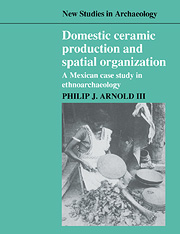Book contents
- Frontmatter
- Contents
- List of figures
- List of tables
- Acknowledgements
- 1 Introduction
- Part 1 Ceramic production and consumption in Los Tuxtlas
- 2 The ceramic production environment
- 3 Ceramic production in Los Tuxtlas
- 4 Ceramic consumption in Los Tuxtlas
- Part 2 Ceramic production and spatial organization
- Part 3 Application and implication
- References
- Index
2 - The ceramic production environment
Published online by Cambridge University Press: 02 December 2009
- Frontmatter
- Contents
- List of figures
- List of tables
- Acknowledgements
- 1 Introduction
- Part 1 Ceramic production and consumption in Los Tuxtlas
- 2 The ceramic production environment
- 3 Ceramic production in Los Tuxtlas
- 4 Ceramic consumption in Los Tuxtlas
- Part 2 Ceramic production and spatial organization
- Part 3 Application and implication
- References
- Index
Summary
Although central to the study of ceramic ecology (e.g. Matson 1965), the role of the environment in ceramic production has only recently been addressed in a systematic fashion (Arnold 1985). Arnold's ethnographic synthesis demonstrates how both the natural and social environment are intimately related to the character and tempo of pottery manufacture. For example, the availability and quality of clay, temper, and fuel can help determine the location and scale of production efforts (Arnold 1985:20–60; Nicklin 1979). Climate can regulate drying time, firing opportunities, and the length of the production season (Arnold 1985:61–98). Population pressure and market demand may also contribute to the development and trajectory of a production industry (Arnold 1985:171–201; Rice 1984a:249–250, 255–257).
This chapter describes the Tuxtlas production environment from the perspective of ceramic ecology. It places the potters and production communities in a natural and social environmental context and explores some of the factors regulating pottery manufacture. These factors include weather patterns, the quality and accessibility of raw material, and the demographic and labor organization of the Tuxtlas potters.
This ecological discussion underscores the relative homogeneity in the Tuxtlas production environment. Potters have access to similar suites of raw material and there are minimal climatic differences between the production communities. The potters' social environment is characterized by comparable household demographics and subsistence activities. Given this overall similarity, one might also expect consistency in the potters' tools and production techniques.
- Type
- Chapter
- Information
- Domestic Ceramic Production and Spatial OrganizationA Mexican Case Study in Ethnoarchaeology, pp. 11 - 34Publisher: Cambridge University PressPrint publication year: 1991



